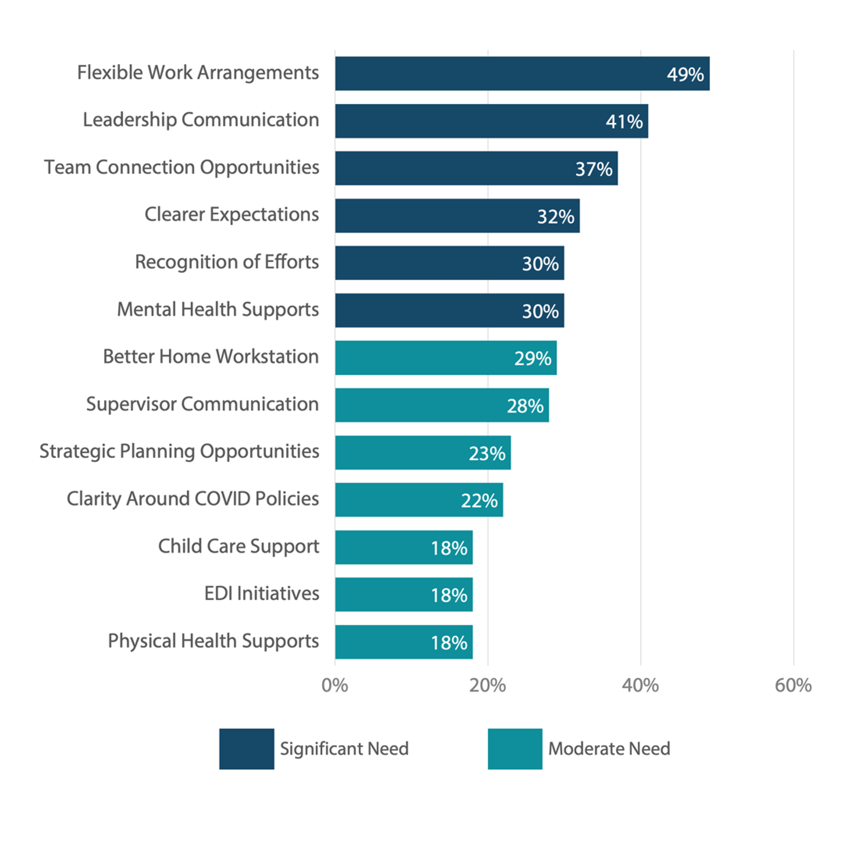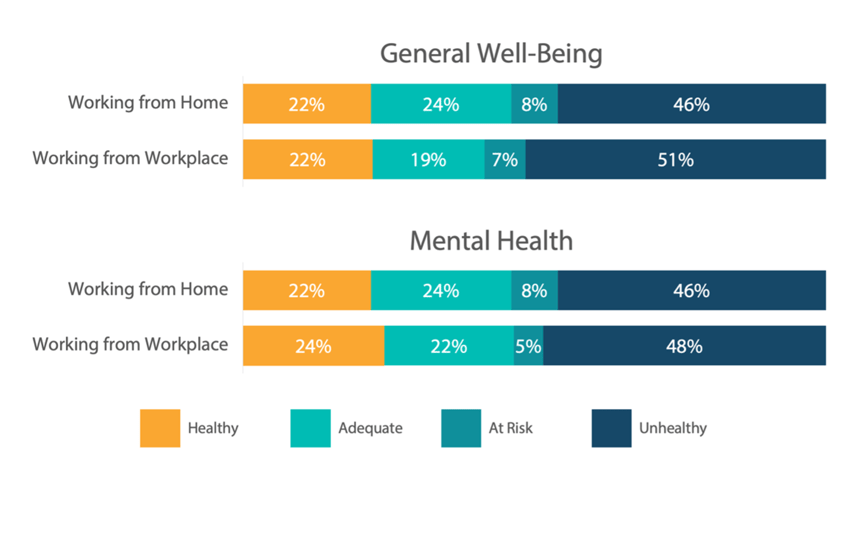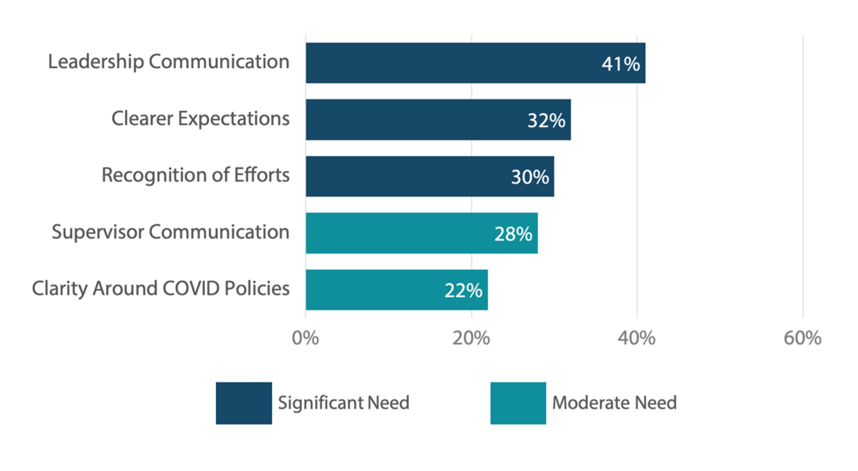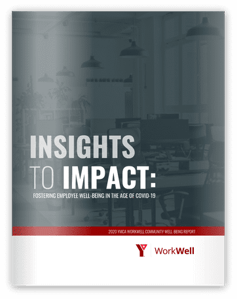Insights to Impact
In 2020, Covid-19 presented a clear and unique challenge to how and where we work. Our Insights to Impact report highlights how it affected well-being in the workplace.
A Call to Action - Where Do We Start?
Understanding where employees are struggling is an important first step to tackling these issues, but our WorkWell mandate is not to simply generate insights on workplace well-being, it is to improve workplace well-being in our communities. With this in mind, the next critical step in this process is to clearly identify what leaders can start doing today to start to address employee well-being so we can restore well-being to pre-COVID-19 levels where needed, and continue to protect well-being in organizations that have weathered the storm.
We acknowledge that employees themselves have an important role in their personal well-being; however, the most impactful workplace well-being initiatives start at the top. In the workplace, it is leaders who determine what is possible, what is acceptable, and what is supported. Without clear support from leadership, many employee well-being initiatives do not even have an opportunity to take off. That is why this section is focused primarily on identifying what leaders can start doing today to tend to the well-being of their employees.

Figure 6. Most common employee needs broken out by percentage of respondents identifying each need
To help identify these opportunities, our WorkWell Community Well-Being Survey asked respondents to identify what they believed they needed most in the next three months in order to feel like they could be healthy and high-performing at work. Figure 6 illustrates the most commonly identified needs in our communities.
Building off of these needs, here are four things that leaders can start doing today to improve the well-being of their employees in the coming months.
"My work life has become fractured. My wife and I take turns being with our toddler while the other tries to power through work. I find myself working until midnight most nights just to keep up.”
- Married father of one, Manager working from home
1. Provide Flexibility and Control
Less than a year ago, the ability to work from home was a perk. Employees could craft their schedules in a way that worked for them and their needs. However, the novel challenges of COVID-19 have meant that working from home is a far cry from the perk that it once was. Put simply: working from home is not a perk when it is mandatory. This distinction was demonstrated quite clearly in our data: 66% of respondents continued to work entirely from home five months into COVID-19, and yet 53% of employees working from home, and 49% of all respondents cited a need for more flexibility in the next three months to help maintain their well-being and mental health at work - the most commonly cited need in our community.
As work-from-home policies became a mandate for many employees, our understanding of what constitutes “flexible work-from-home policies” has changed. This is because every employee’s work-from-home experience brought its own unique challenges. Many employees have fought to maintain productivity while trying to support their families, stay connected with limited Internet capabilities, educate their children, and/or trying to work from inadequate workstations such as couches and kitchen tables. There simply is no one-size-fits-all approach given the wide range of challenges many employees have faced working from home during COVID-19.
We saw evidence of these challenges in the data as well: Figure 7 compares the General Well-Being and Mental Health of those working from home and those working from their workplace during COVID-19. The most striking takeaway from these results is how similar these two groups are, despite both groups having significantly different work experiences. It is clear, however, that working from home during COVID-19 has been anything but a perk, and new solutions are required to address these challenges.

Figure 7. General Well-Being and Mental Health by working arrangement
There is a clear place to start, however, and that is peoples’ need for control. The ability to work from home used to be considered a perk because it allowed employees to bend their work around their life. They could choose to stay home when a child was sick or take an important doctor’s appointment during the middle of the day. While deadlines and productivity were still critical, the ability to work from home allowed employees to support their own mental health by giving them the opportunity to engage with their work in a way that worked for their own needs. During COVID-19, however, this sense of control was lost. Working from home was no longer a “flexible option” as work crept into the home because it had to, not because employees wanted it to, and this has had important ramifications for employees’ mental health.
The need for flexible work arrangements has not been limited to those working from home. While much of the COVID-19 narrative has focused on the shift to working from home, many employees have continued to face rigid, in-person shift work, inflexible jobs, and immovable schedules, all while having to manage their concern for families at home and the anxieties of potentially contracting the virus at work. Similar to those working from home, approximately 50% of those working from their workplace during COVID-19 had Unhealthy scores in General Well-Being and Mental Health, and 34% cited a need for more flexible work arrangements to improve their health at work.
Overall, the need for more flexible work arrangements was the most commonly cited need across all groups and employee types.
To adequately address this need, leaders need to revisit the ways in which work has historically been inflexible and consider how they can begin to change their approach to tend to the long-term well-being of employees, particularly by considering how to provide employees with more control over how they choose to work. While there are many ways to provide employees with flexible work arrangements, here are some ideas to help leaders start to make changes today:
1. Prioritize deliverables over hours spent at work.
Mandating strict hours of work creates inflexible structures that can be detrimental to employee well-being during difficult times. Where possible, focusing on deliverables over hours spent at work allows employees to create a work-life that works for them and provides equal flexibility across different employee groups. For example, some parents might prefer to focus on their children in the early mornings and late afternoons and work additional hours after their children are in bed. Some employees might prefer to structure their workday around when public transit is most accessible, others might choose to stick to the more traditional 9-5 structure. What is important is that, where possible, employees have the choice to structure their work and meet their clear deliverables in a way that works for them and their own unique needs.
2. Offer a flexible well-being stipend.
Many health benefits are well-intentioned in theory, but inflexible in practice. For example, gym membership subsidies may support the well-being of some employees, but can fall short for others who prefer to exercise at home. Flexible stipends, on the other hand, offer employees a valuable level of control. An open-ended well-being stipend (e.g. $500 that employees can direct to any costs associated with their well-being) allows employees to cover the costs of their own, unique well-being needs. Some employees might use those funds to subsidize their gym membership, whereas others may improve their workstation (a need identified by 37% of employees working from home) or secure additional childcare support (a need identified by 33% of working parents). What is important is that employees have the choice to use the subsidy in a way that works best for their own needs.
This type of flexibility presents a significant departure from the norm for many organizations, but the challenges of COVID-19 have only served to illustrate how valuable it can be.
Forty-nine per cent of all employees have clearly identified flexibility as a critical need for their well-being in the next three months, and finding clear ways to incorporate control and choice into how they deliver their work will help give employees the mental resources they need to be their best at work as our communities recover.
"We are working from home, constantly on Zoom meetings and the email communication with cc: on everything is exhausting. Many of us are paranoid that we will lose our jobs. This was a low trust environment before COVID-19, but it is only worse now and our weak culture is showing.”
- Married mother of one, Director, working from home
2. Foster Healthy Cultures with Strong Foundations
In prior sections, we discussed the critical importance of the foundations of culture in supporting employee well-being. These cultural foundations were identified as some of the most significant workplace needs for employees in our communities. Figure 8 shows five of the top ten needs identified by respondents and speaks to a significant need in our communities for healthy organizational cultures where employees experience regular and effective Recognition, Communication, and Feedback.
Importantly, these behaviours do not need to carry significant costs; but by regularly devoting energy and effort into these areas, leaders can address employee well-being head-on by minimizing uncertainty, providing clear direction, and helping them feel like valued members of their organization.

Figure 8. Percentage of respondents identifying different foundations of culture as a notable need to feel healthy at work in the next three months
Here are some clear suggestions to promote effective recognition, communication, and feedback in the workplace:
1. Timely communication is the best communication.
One of the most common cultural challenges we hear is that employees do not get critical information when they need it. This is even more damaging when employees receive critical information through informal gossip or back channels. Whether it is important organizational decisions, recognition of a job well done, or critical feedback on a project, effective communication has a half-life. The best cultures focus less on waiting to craft the “perfect” communication, and more on creating timely dialogue that is inclusive and timely.
2. Be specific and explain the why.
Feeling like a valued member of something bigger than yourself is one of the strongest predictors of mental health at work. To help employees understand their worth, context is critical. By explaining the why, leaders bring others into their decisions and demonstrate the importance of their team. For example, “we made this decision because...”, “your efforts have been so important to this team because...”, “I am looking for more from you here because...”. The why provides clarity and direction, but most importantly, it communicates meaning, one of the critical building blocks to healthy cultures.
4. Recognize the effort as much as the outcome.
One of the biggest mistakes we see with recognition is the belief that only the outcome deserves appreciation. This overlooks the reality, however, that the bulk of the work often goes into the process rather than the outcome. Recognize small milestones along the way – say “thank you” by identifying why employees’ efforts are important, and why their contributions are valuable. Increasing these positive touchpoints also provides additional opportunities for constructive feedback and direction along the way. Stop waiting for the final product, and actively look for the moments that deserve appreciation along the way.
5. Confirm they understand.
What leaders say and what they mean isn’t always what is heard. Effective communication is clear and concise, and requires empathy from the speaker as much as it does from the listener. To help ensure that both parties are on the same page, leaders can ask the listener to repeat what they heard, to raise any thoughts or concerns that they might have, and to identify areas that require clarification. Communication is a two-way street, and some of the most important work happens after the message is delivered.
On the surface, many of us know that these are important leader behaviours. In our experience, however, significant gaps between knowledge and practice exist at all levels – executives, directors, managers, and team leaders. Remember: just because it is common sense does not mean that it is a common action, and in times of crisis, these gaps have an even most significant impact on the well-being of employees. Healthy cultures create the conditions for healthy employees, but they require active and consistent effort. It all begins with the little behaviours.
My physical health has been good but there has been a ton of anxiety and stress - about how I'm performing at work and if I'm adding enough value, concern about my child's well-being and social isolation, concern about my partner's job and their well-being and mental health, worry about elderly parents, etc. It doesn’t seem to end.”
- Married mother of one, working at home
3. Mental Health Supports
One of the most common threads throughout these results is the significant impact of COVID-19 on Mental Health in our communities, regardless of industry, employment type, and demographics.
 Figure 9. Mental Health response breakdown
Figure 9. Mental Health response breakdown
There is a clear cause for concern: 47% of respondents had Unhealthy Mental Health scores, and 30% cited a need for more Mental Health Supports to feel healthier at work in the next three months. Likely, these numbers will only continue to climb as the long-term effects of COVID-19-related stress and uncertainty continue to drag on into the winter months.
It is important to clarify that this is not only a workplace issue. COVID-19 has affected mental health in our communities in many ways – however, it is undeniable that:
(1) our changing job demands and work experiences have played a big role in how mental health has evolved in our communities during the pandemic, and
(2) organizations can play a critical role in supporting mental health in our communities.
Here are some important suggestions on what leaders, managers, and supervisors can do to support their teams through the next stages of the pandemic:
1. Workload and time management matter.
Unmanageable demands were one of the most frequently mentioned challenges in the data, with many respondents stating that COVID-19 led to increased demands with fewer resources and smaller teams. As a manager or leader, it is important to clearly identify your top priorities so employees know where their limited resources should be focused. Assume that your employees are operating with a lower mental bandwidth than normal; connect with employees to discuss their workload, whether they feel able to meet their objectives, and what specifically you can do as a leader to support them.
2. Support mental health through physical activity.
Physical exercise has many benefits in supporting mental health – it can help to improve self-esteem, decrease negative thoughts, and improve overall well-being. Consider leading by example; where possible, take physically distanced team walks or have walking meetings with a team member. If you are working remotely, consider virtual walking meetings where parties call in while walking around the block. This active change of scenery has proven benefits, and even simple exercise brings much-needed oxygen into our brain. Leaders should lead by example and demonstrate how this type of activity is not only acceptable, but encouraged.
3. Start with empathy and honesty.
Be careful not to gloss over the realities that exist on your team. Be honest and transparent – the stigma of mental health is only amplified if you try to act as if “everything is fine” when your team is struggling. By sharing your own concerns and struggles, you can build trust and signal that it is acceptable to discuss these issues. Make the time for regular check-ins to understand employees’ needs and create an anonymous channel for employees to voice their needs and concerns if needed. You will likely not be able to address every concern, but knowing what these needs are is an absolutely critical first step.
4. Clearly communicate what services are provided through your Employee Assistance Program (EAP).
A recent industry trends report found that only 7% of employees use the services provided through their EAP. As a leader, there are many things you can do to increase usage in your organization. First, provide a resource that clearly states the full breadth of services your EAP offers and why those services are valuable, and offer a step-by-step guide on how to access them. Second, create a dedicated email address that employees can reach out to for help in accessing their EAP. There are many personal reasons why someone might not reach out to an EAP, but as a leader, it is up to you to provide information on what your EAP provides, how it can be accessed, and why it can be so important.
5. Educate yourself and your employees.
To best support mental health in the workplace, it is important to understand the basics and how employees might be feeling when they consider returning to the workplace. The Canadian Mental Health Association has created a fantastic toolkit for leaders and employees alike. This is a great place to start. Having this framework will help you empathize with and support people who may need help. Access the Toolkit online.
Addressing Mental Health in the workplace is a significant challenge. While mental health supports like an EAP can be valuable tools in an organization’s arsenal, true change only begins when leaders clearly and openly take mental health seriously.
The best well-being strategies at work are holistic, leveraging mental health supports to complement a healthy culture with clear communication around the importance of mental health and regular check-ins to understand the most significant challenges faced by employees.
While mental health is the product of many considerations in someone’s life, it is time for organizations to fully own their share of the responsibility in mental health in our communities.
4.Understand Your Employees’ Unique Needs
These results represent 1,200 employees across a wide range of organizations, industries, and demographics, but it is important to stress that these results might not be indicative of the unique needs within your organization. For example, 18% of respondents identified a clear need for more Equity, Diversity, and Inclusion Initiatives to feel healthy at work. However, that need could exist across 100% of employees within your organization, or 100% of BIPOC employees within your organization. These numbers simply represent clear goalposts for you to work from, but to effectively target well-being in your own organization, you need to clearly identify the unique needs of your employees.
The best way to identify the needs of your employees is to directly involve them in the process. To do this effectively, there are a number of important criteria that should be addressed:
- Ensure that employee surveys or feedback mechanisms clearly assess employee well-being. The most significant employee needs in the COVID-19 world are rarely addressed by the big, annual engagement survey. If you want to understand and support the well-being needs of your employees, it’s critical to clearly and directly measure them. If you are not collecting the right data, your hands will be tied before you even start.
- Ensure there is a quick turnaround in the feedback process. Change is constant in organizations, and this has been particularly true during COVID-19. This means that data can become stale quickly, and if you are waiting even a month to process and receive employee feedback, the opportunity to create positive change might be lost. The feedback process needs to be nimble so you can be nimble in your action.
- Ensure that you close the loop quickly. After you have received employee feedback, it is critical to quickly communicate to employees what you heard and how you plan to act to support their needs.
As with any data-driven approach, the clearest first step leaders can take in supporting employee well-being is to understand the unique needs of their own employees to ensure that interventions are directly targeting their employees’ actual needs. Long-term, this process is also a powerful way to build a healthy, trusting culture. By building a strategy around regular employee feedback, leaders can ensure that they are basing their decisions on actual needs rather than their assumptions.
Our Next Steps as YMCA WorkWell
In the coming months, our team at YMCA WorkWell will release additional infographics based on some of the nuances in our data. For example, new infographics and insights will be released on the workplace well-being of working parents, part-time employees, and different age groups during COVID-19. Please visit our landing page for the first infographic on what employees can do to support their well-being in the coming months.
This winter, we will gather more insights and release our first WorkWell Special Issue Report on the relationship between Equity, Diversity, and Inclusion and workplace well-being – specifically examining how employees with different ethnicities, identities, and backgrounds experience work and workplace well-being in our communities.
In the meantime, we are here to help. Our YMCA WorkWell team offers data-driven insights, webinars, workshops, and professional development opportunities to help your team tackle workplace well-being head-on. Even pre-COVID-19, only 12% of leaders felt that they were ready to adequately address employee well-being, despite 80% of leaders believing that it was an important priority for their organization. COVID-19 has only widened this gap, but you do not have to be helpless. You just have to be intentional.
